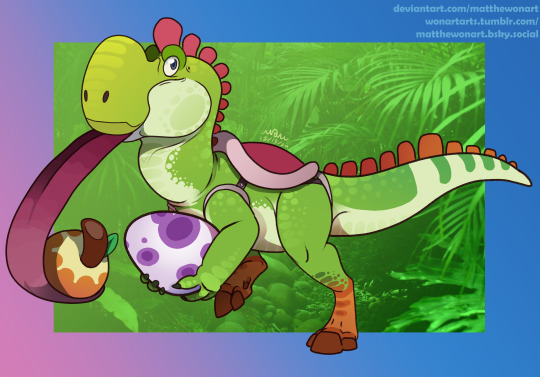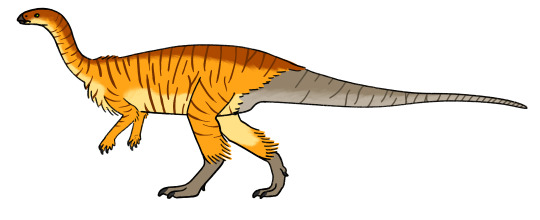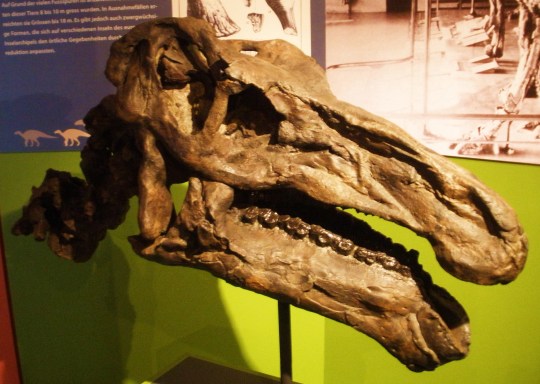#iguanodontian
Explore tagged Tumblr posts
Text
#Paleostream 20/07/2024
here's today's #Paleostream sketches!!! today we drew Morturneria, Atopodentatus, Comptonatus, and Trigonosaurus




#Paleostream#sketch#sketches#paleoart#paleontology#digital art#artists on tumblr#digital artwork#palaeoart#digital illustration#sciart#id in alt text#paleoblr#palaeoblr#plesiosaur#marine reptile#elasmosauridae#aristonectinae#Morturneria#triassic#cretaceous#maastrichtian#now draw her giving birth#Comptonatus#iguanodontian#ornithischian#sauropod#Atopodentatus#Trigonosaurus
159 notes
·
View notes
Text

An illustrated assortment of some of the various dinosaurs (all of them shown not to scale for convenience) that inhabit the semiarid Early Cretaceous neighborhood of Utahraptor ostrommaysorum. Among the most unusual of these neighbors are the indeterminate sail-backed Iguanodontian that has still not been formally described, the small but highly-enigmatic Therizinosaur Martharaptor, and the Turiasaurid Mierasaurus, which is a rare Cretaceous and North American representative of an otherwise mainly Jurassic and European family of sauropods.
#paleoart#dinosaur#dinosaurs#paleontology#utahraptor#dromaeosaurs#dromaeosaurid#dromaeosaur#iguanacolossus#cedarosaurus#ornithopods#ornithomimosaur#ornithischian#sauropod dinosaur#sauropod#palaeontology#palaeoart#paleoblr#paleoartist#paleoartists on tumblr#paleontologie#paleontology art#palaeoblr#paleontography#early cretaceous#theropod dinosaurs#theropod dinosaur#theropods#paleoillustration#falcarius
139 notes
·
View notes
Photo

A Yoshi to go with the Bowser I drew. Ended up speculating a bit solely because I did not want to figure out how to give him shoes. Mainly based on Iguanodontian Ornithopods like Muttaburrasaurus.
Posted using PostyBirb
66 notes
·
View notes
Text
Emiliasaura alessandrii Coria et al., 2024 (new genus and species)

(Foot of Emiliasaura alessandrii [scale bar = 10 cm], from Coria et al., 2024)
Meaning of name: Emiliasaura = [founder of the first museum in Las Lajas] Emilia "Grandma" Ondettia de Fix's lizard [in Greek]; alessandrii = for Carlos Alessandri [discoverer of the original fossil]
Age: Early Cretaceous (Valanginian)
Where found: Mulichinco Formation, Neuquén, Argentina
How much is known: Partial skeletons of two individuals (together including a complete hind limb and parts of the forelimb, hips, and tail) as well as an isolated back vertebra.
Notes: Emiliasaura was an iguanodontian, a diverse group of plant-eating dinosaurs that includes the duck-billed hadrosaurids. The describers of Emiliasaura suggest that it was closely related to rhabdodontids, a group of small- to medium-sized iguanodontians from Europe. If this is correct, Emiliasaura would be the oldest known rhabdodontid-like iguanodontian, and the first one known from South America. Based on microscopic examination of their bone structure, the two partial skeletons known of Emiliasaura both belonged to individuals that hadn't grown to full size when they died.

(Schematic skeletal of Emiliasaura alessandrii [scale bar = 1 m], with bones preserved in the two more complete specimens in black, from Coria et al., 2024)
Reference: Coria, R.A., I.A. Cerda, F. Escaso, M.A. Baiano, F. Bellardini, A. Braun, L.M. Coria, J.M. Gutierrez, D. Pino, G.J. Windholz, P.J. Currie, and F. Ortega. 2024. First Valanginian (Early Cretaceous) ornithopod (Dinosauria, Ornithischia) from Patagonia. Cretaceous Research advance online publication. doi: 10.1016/j.cretres.2024.106027
85 notes
·
View notes
Text
Archovember 2024 Day 14 - Cuspicephalus scarfi

Cuspicephalus scarfi was a wukongopterid pterosaur from Late Jurassic England. It’s name comes from the Latin cuspis for “point” and the Greek κεφαλή for “head”, and its species name is a reference to Gerald Scarfe who was known for caricatures with very pointy noses (including Margaret Thatcher as the “Torydactyl), and who was also the production designer for Disney’s Hercules. Cuspicephalus scarfi basically means “pointed head which could have been designed by Gerald Scarfe.” Looking at this animal you can probably see the resemblance! Cuspicephalus had a very long, angled skull, most of which was occupied by the air pockets in its fenestra. A low bony crest is present, which was likely the base of a much higher soft tissue crest. Like most other Jurassic pterosaurs, it had sharp interlocking teeth, and likely also had a long ornamented tail. Due to its small size and lightly built skull, it probably fed on small land animals like arthropods and worms.

Cuspicephalus scarfi was found in the Kimmeridge Clay Formation. This was a seaside environment and is known for its many fish, turtle, plesiosaur, and icthyosaur fossils. Other pterosaurs have been found here as well, but from later ages than Cuspicephalus. Other archosaurs would have included the stegosaur Dacentrurus, the iguanodontian Cumnoria, the megalosaurid Torvosaurus, and the thalattosuchians Bathysuchus, Cricosaurus, Dakosaurus, Metriorhynchus, Plesiosuchus, and Torvoneustes.

This art may be used for educational purposes, with credit, but please contact me first for permission before using my art. I would like to know where and how it is being used. If you don’t have something to add that was not already addressed in this caption, please do not repost this art. Thank you!
#sorry it’s late I did post this this morning but Tumblr glitched and then it disappeared and wouldn’t let me repost it#had to log out and back in once I had better internet but now we’re here#Cuspicephalus scarfi#Cuspicephalus#Wukongopterid#pterosaurs#archosaurs#archosauromorphs#reptiles#Archovember#Archovember2024#Dinovember#Dinovember2024#SaritaDrawsPalaeo#Late Jurassic#England#Kimmeridge Clay Formation
37 notes
·
View notes
Text
Talenkauen

Talenkauen is a basal iguanodont from the Late Cretaceous of Argentina. It was a small bipedal herbivore with teeth in the tip of its beak, unlike more derived iguanodontians. It grew to around 4.5 m in body length, and weighed about 300 kg. Talenkauen had a proportionally long neck, and a small head for which it is named. Shared features with other South American ornithopods suggest that there was a distinct Southern Hemisphere ornithopod group. Talenkauen specimens include the first hatchling ornithopod discovered in the Southern Hemisphere.
57 notes
·
View notes
Text


Patreon request for Magno/rome.and.stuff - Ichthyovenator laosensis!
Icthyovenator is a Spinosaurid from the Early Cretaceous of Laos. Known only from fragmentary material, it seems to be unique among Spinosaurids for the strange divot in its spine. (In this depiction, I’ve also added another small divot further up the back; however, we don’t have that much of the spine, so this is purely speculative.) This strange sail could have been used for display or species recognition. Like other spinosaurines, Icthyovenator was likely adapted for a semi-aquatic lifestyle, hunting aquatic prey like fish, amphibians, and small dinosaurs. Like Spinosaurus, it had unusually tall vertebral spines on its tail which likely aided in swimming.
While it certainly wasn’t snacking on sauropods (except possibly via scavenging), it lived alongside large ones like Tangvayosaurus. Trackways in the Grès Supérieurs Formation belong to sauropods, iguanodontians, and neoceratopsians, though fish and turtles make up the majority of this ancient habitat.
~~~~~~~~~~~~~
This was a nice warmup for Archovember, and it’s also good to have another Spinosaurid under my belt. I should redraw Baryonyx and give it a size chart. Maybe someday I’ll have enough to make a full spinosaurid comparison chart. 🤔
Btw, the request tier for Patreon starts at only $5 a month. 😉 Link is pinned at the top of my blog.
#Ichthyovenator laosensis#Ichthyovenator#Spinosaur#spinosaurid#theropods#dinosaurs#archosaurs#SaritaDrawsPalaeo#saurischians
96 notes
·
View notes
Text

A section of dinosaur tibia from an indeterminate iguanodontian from the Wadhurst Clay Formation in Bexhill-on-Sea, East Sussex, England. This specimen was originally labeled as an Iguanodon from the Wealden Formation collected in 2002. However, Iguanodon does not occur in this deposit which is too old for the genus, but does contain two other iguanodontians, Hypselospinus fittoni and Barilium dawsoni.
#dinosaur#fossils#paleontology#palaeontology#paleo#palaeo#hypselospinus#barilium#ornithopod#iguanodontidae#ornithischian#cretaceous#mesozoic#prehistoric#science#paleoblr#ヒプセロスピヌス#バリリウム#イグアノドン類#恐竜#化石#古生物学
5 notes
·
View notes
Text
in more important news
7 notes
·
View notes
Text
MOTHER'S CROWN
GARDEN OF THE GODS
COLORADO SPRINGS, COLORADO
Post 3 of 3 for this game location
(See my first two posts about this location, linked below!)

Photo by James St. John of a Holotype skull (white parts are reconstructed)
"In 1878, Professor James H. Kerr of Colorado College discovered what he believed to be 'portions of 21 different sea monsters' in the Garden of the Gods Park." (article below)
It turned out not to be a sea monster at all, but an herbivorous iguanodontian dinosaur! It took a long journey of 130 years to finally identify it as a species not yet found anywhere else, now named after the Garden of the Gods: Theiophytalia Kerri.
Read about that journey here:
#horizon zero dawn#gaming tourism#horizon landscapes#horizon locations#horizon irl#hzd#the nora#nora tribe#nora sacred land#mothers crown#mother's crown#dinosaurs
7 notes
·
View notes
Note
Yo, Dexter. A little fun fact about dinosaurs.

The early Cretaceous iguanodontian ornithopod from North America called Tenontosaurus had a notorious rivalry with the early Cretaceous dromaeosaurid Deinonychus, which lived in the same region at the same time as Tenontosaurus.

Dexter: wow
3 notes
·
View notes
Text
The European Tyrant

(August 2, 2022)
My other spec project (C:ToM) will be on temporary hiatus though I might post my old spec evo-species from Fandom (a shitty site) and other content, perhaps Monster Hunter, who knows.
Eurotyrant is a genus of large Late Cretaceous carnivorous theropod dinosaurs within the family Eurotyrantidae. Before its reclassification, it was once thought to be a species of tyrannosauroid due to its resemblance to the famous tyrant lizard king, though similarities between compsognathid dinosaurs and eurotyrantids revealed a secret: eurotyrantids weren't tyrannosauroids, but rather pancompsognathian* maniraptoromorph theropods descended from compsognathids. In this alternate timeline where most Cretaceous European theropod genera are absent, the compsognathids took over the megafaunal niche.
Now, back to Eurotyrant. Fossils of this particular genus are known from rocks dating to the Late Cretaceous period, 78 to 66 million years ago. The four species in this genus are E. rex, E. gigante, E. magnis, and E. gracilis. The largest being E. gigante (21 ft tall, 45 ft long) with the smallest being E. gracilis (5 ft tall, 20 ft long), E. rex and E. magnis are similar in size (10 ft tall, 30 ft long).
Unlike the tyrannosaurids which it resembled, this beast had three digits instead of two, here it is depicted with colorful protofeathers on its arm, the presence of large muscles implies that they were used both for courtship and holding onto partners during mating. Now we know what they might have been used for, what were those modified quadratojugal bones used for, species recognition?
Eurotyrant lived in an open steppe-like ecosystem composed largely of ferns since grasses didn't reach their peak until the Cenozoic. Adults were predators of sauropods, ankylosaurs, crocodylomorphs, and iguanodontian dinosaurs, though the juveniles were so morphologically and ecologically different, feeding on birds, insects, crustaceans, eggs, small reptiles, amphibians, and fish, that they were thought to be a separate species, Microphoneus imperiosus (meaning domineering small murderer).
Here is a juvenile, gracile and feathered:

*compsognathids are probably polyphyletic with most of them being carnosaurs (I didn't know that 2 years ago when this was posted on Fandom, for all I know, Eurotyrant could be a true tyrannosauroid or a tyrannosaur-convergent allosauroid)
5 notes
·
View notes
Text
Talenkauen santacrucensis

Talenkauen was a genus of neornithischian dinosaur from the Late Cretaceous period. Its type species is T. santacrucensis. The only specimen was found on Los Hornos Hill on the coast of Viedma Lake in Patagonia, Argentina. This specimen was found lying next to a scattering of fragmentary bones and teeth, which has been identified as a recently-hatched baby T. santacrucensis.
Talenkauen means "small skull;" its root words "talenk" and "kauen" originate from the Aonikenk language.
Its autapomorphies include a well–developed epipophysis on cervical 3 and plate–like unicate processes on the rib cage.
Talenkauen was a bipedal herbivorous dinosaur. It was at most 4 meters long, with a similar build to Dryosaurus, having short limbs, a long trunk and neck, and a small head. It was found to be closely related to Macrogryphosaurus and the clade Elasmaria was erected for the two genera. As of 2019, Elasmaria now includes almost a dozen genera.
Original paper: Novas, Fernando E.; Cambiaso, Andrea V; Ambrioso, Alfredo (2004). "A new basal iguanodontian (Dinosauria, Ornithischia) from the Upper Cretaceous of Patagonia". Ameghiniana. 41 (1): 75–82.
Wikipedia article: https://en.m.wikipedia.org/wiki/Talenkauen
#dinosaur#dinosauria#paleoart#paleontology#artwork#original art#human artist#talenkauen#elasmaria#neornithischia#ornithischia#obscure fossil animals#obscure fossil dinosaurs#obscure fossil tetrapods
21 notes
·
View notes
Photo

An early-diverging iguanodontian (Dinosauria: Rhabdodontomorpha) from the Late Cretaceous of North America
Lindsay E. Zanno ,Terry A. Gates, Haviv M. Avrahami, Ryan T. Tucker, Peter J. Makovicky
Abstract
Intensifying macrovertebrate reconnaissance together with refined age-dating of mid-Cretaceous assemblages in recent decades is producing a more nuanced understanding of the impact of the Cretaceous Thermal Maximum on terrestrial ecosystems.
Here we report discovery of a new early-diverging ornithopod, Iani smithi gen. et sp. nov., from the Cenomanian-age lower Mussentuchit Member, Cedar Mountain Formation of Utah, USA.
The single known specimen of this species (NCSM 29373) includes a well-preserved, disarticulated skull, partial axial column, and portions of the appendicular skeleton. Apomorphic traits are concentrated on the frontal, squamosal, braincase, and premaxilla, including the presence of three premaxillary teeth. Phylogenetic analyses using parsimony and Bayesian inference posit Iani as a North American rhabdodontomorph based on the presence of enlarged, spatulate teeth bearing up to 12 secondary ridges, maxillary teeth lacking a primary ridge, a laterally depressed maxillary process of the jugal, and a posttemporal foramen restricted to the squamosal, among other features.
Prior to this discovery, neornithischian paleobiodiversity in the Mussentuchit Member was based primarily on isolated teeth, with only the hadrosauroid Eolambia caroljonesa named from macrovertebrate remains. Documentation of a possible rhabdodontomorph in this assemblage, along with published reports of an as-of-yet undescribed thescelosaurid, and fragmentary remains of ankylosaurians and ceratopsians confirms a minimum of five, cohabiting neornithischian clades in earliest Late Cretaceous terrestrial ecosystems of North America.
Due to poor preservation and exploration of Turonian–Santonian assemblages, the timing of rhabdodontomorph extirpation in the Western Interior Basin is, as of yet, unclear. However, Iani documents survival of all three major clades of Early Cretaceous neornithischians (Thescelosauridae, Rhabdodontomorpha, and Ankylopollexia) into the dawn of the Late Cretaceous of North America.
Read the paper here:
https://journals.plos.org/plosone/article?id=10.1371/journal.pone.0286042
23 notes
·
View notes
Text
Comptonatus chasei Lockwood et al., 2024 (new genus and species)


(Dentary [lower jaw bone] and schematic diagram of the skull of Comptonatus chasei [scale bars = 50 mm for the dentary and 100 mm for the skull diagram], with preserved bones in yellow, from Lockwood et al., 2024)
Meaning of name: Comptonatus = Compton thunderer [in Latin]; chasei = for Nick Chase [discoverer of the original fossil]
Age: Early Cretaceous (Barremian)
Where found: Wessex Formation, Isle of Wight, U.K.
How much is known: Nearly complete skeleton of one individual.
Notes: Comptonatus was an iguanodontian, a diverse group of plant-eating dinosaurs that includes the duck-billed hadrosaurids. It is one of the most completely known iguanodontians from Britain and can be distinguished from other British iguanodontians by numerous anatomical features, including a lower jaw that is essentially straight in side view, as well as an expanded forward-pointing projection on the pubis (one of the hip bones). Historically, all large iguanodontian fossils from the Early Cretaceous of southern England were usually assigned to one of two genera, Mantellisaurus and the more robust Iguanodon, but the discovery of Comptonatus adds to a growing understanding that these dinosaurs were more diverse in this general time and region than previously appreciated.
Reference: Lockwood, J.A.F., D.M. Martill, and S.C.R. Maidment. 2024. Comptonatus chasei, a new iguanodontian dinosaur from the Lower Cretaceous Wessex Formation of the Isle of Wight, southern England. Journal of Systematic Palaeontology 22: 2346573. doi: 10.1080/14772019.2024.2346573
80 notes
·
View notes
Text






Iguanodon
(temporal range: 126-122 mio. years ago)
[text from the Wikipedia article, see also link above]
Iguanodon (/ɪˈɡwɑːnədɒn/ i-GWAH-nə-don; meaning 'iguana-tooth'), named in 1825, is a genus of iguanodontian dinosaur. While many species found worldwide have been classified in the genus Iguanodon, dating from the Late Jurassic to Early Cretaceous, taxonomic revision in the early 21st century has defined Iguanodon to be based on one well-substantiated species: I. bernissartensis, which lived during the Barremian to early Aptian ages of the Early Cretaceous in Belgium, Germany, England, and Spain, between about 126 and 122 million years ago. Iguanodon was a large, bulky herbivore, measuring up to 9–11 metres (30–36 ft) in length and 4.5 metric tons (5.0 short tons) in body mass. Distinctive features include large thumb spikes, which were possibly used for defense against predators, combined with long prehensile fifth fingers able to forage for food.
The genus was named in 1825 by English geologist Gideon Mantell but discovered by William Harding Bensted, based on fossil specimens found in England and was given the species name I. anglicus. Iguanodon was the second type of dinosaur formally named based on fossil specimens, after Megalosaurus. Together with Megalosaurus and Hylaeosaurus, it was one of the three genera originally used to define Dinosauria. The genus Iguanodon belongs to the larger group Iguanodontia, along with the duck-billed hadrosaurs. The taxonomy of this genus continues to be a topic of study as new species are named or long-standing ones reassigned to other genera. In 1878 new, far more complete remains of Iguanodon were discovered in Belgium and studied by Louis Dollo. These were given the new species I. bernissartensis. In the early 21st century it became understood that the remains referred to as Iguanodon in England belonged to four different species (including I. bernissartensis) that were not closely related to each other, which were subsequently split off into Mantellisaurus, Barilium and Hypselospinus. It was also found that the originally described type species of Iguanodon, I. anglicus was a nomen dubium, and not valid. Thus the name "Iguanodon" became fixed around the well known species based primarily on the Belgian specimens. In 2015, a second valid species, I. galvensis, was named, based on fossils found in the Iberian Peninsula.
Scientific understanding of Iguanodon has evolved over time as new information has been obtained from fossils. The numerous specimens of this genus, including nearly complete skeletons from two well-known bone beds, have allowed researchers to make informed hypotheses regarding many aspects of the living animal, including feeding, movement, and social behaviour. As one of the first scientifically well-known dinosaurs, Iguanodon has occupied a small but notable place in the public's perception of dinosaurs, its artistic representation changing significantly in response to new interpretations of its remains.
8 notes
·
View notes